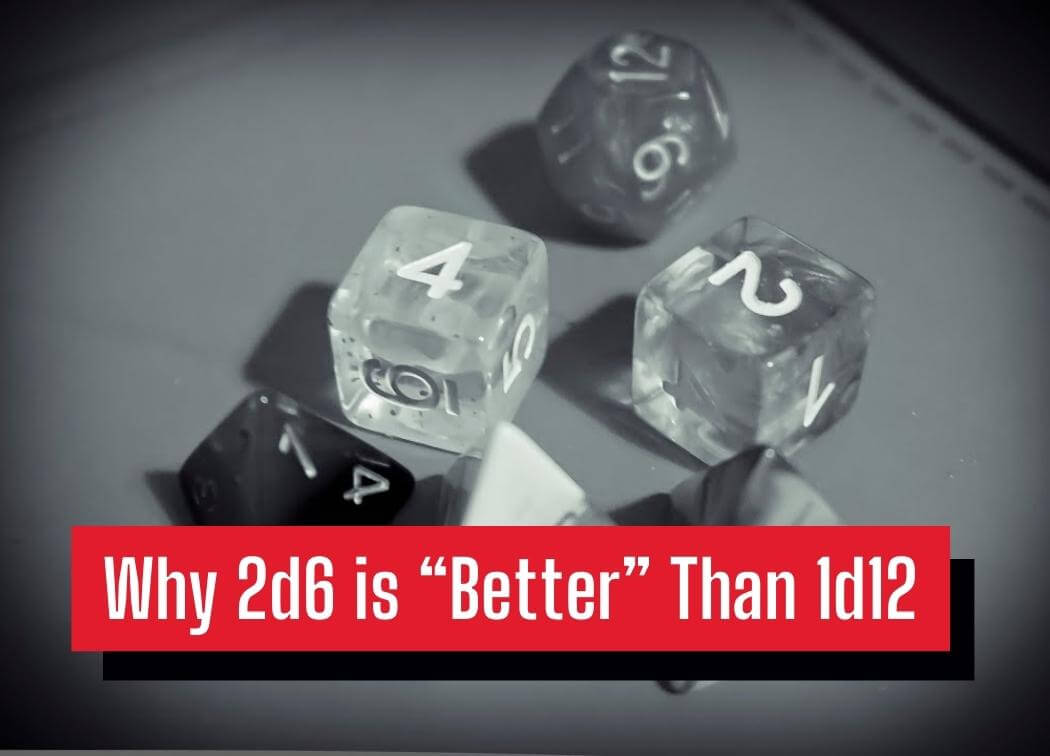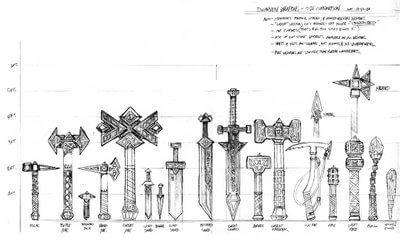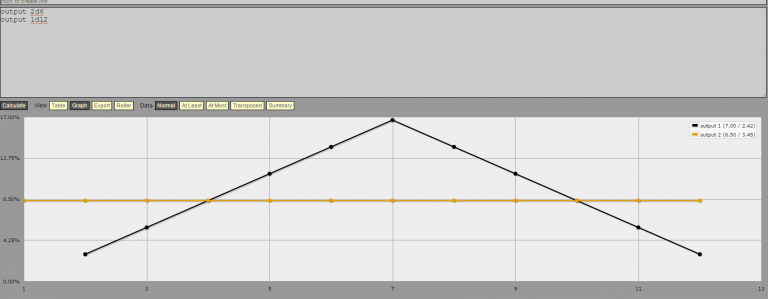Basic Probability AKA Why 2d6 is “Better” Than 1d12

Please note that the following probability calculations will be done based on weapon damage in 5th edition Dungeons and Dragons. Let’s begin with some quick definitions:
Probability is essentially the math behind what your chances are of getting a certain randomly generated number.
A randomly generated number is a number that is taken out of a list of potential numbers. This list tends to have constraints, for example, the number can be any number between 1 and 100.
A random number generator is something that generates a random number based on constraints given to it.
One great example of a random number generator and something any D&D player is very familiar with is a die. A d20 has a constraint of numbers between 1 and 20 and the die can only “choose” one number through pure chance. Of course with magical items and stat bonuses the player can make the number be more in their favor, but the base value is still randomly selected.
The Problem
Dagg is a mighty Barbarian. He wants a two-handed weapon to aid him in his quest to lob the heads off of anyone who stands in his way. However, Dag wants to do the most reliable damage as physically possible and money is not an issue (cost-efficiency can be another post!).
Should he purchase the greataxe that deals 1d12 slashing damage or the greatsword that deals 2d6 slashing damage? Note that I am choosing these two weapons because they deal the same amount of maximum damage, 12, and they are the same damage type. Whenever you are going to compare any sort of scientific data, always have constant variables and one variable that changes, in this case, it is the reliability of the damage done.
Probability
The calculation of probability is very simple. Essentially you decide the number you wish to roll and then add the possible combinations of arriving at that number together. For example. I want to roll a 6 because that is the number in between our minimum (1) and our maximum (12) with both of our rolls. For the 1d12 this is easy because I have a 1 out of 12 (1/12, or 8.33%) chance of rolling ANY number on the d12.
However, for the 2d6 this is a bit more work. See we can roll anywhere between a 1 and a 6 which means we have 6 possible outputs on each random number generator. For the total number of combinations we will multiply our possible outputs together so 6 x 6 = 36 total combinations, aka any given number we desire to roll, we have at LEAST a 1/36 chance of rolling that number. What combinations are there? 1 + 5 = 6, 2 + 4 = 6, 3 + 3 = 6, 4 + 2 = 6, 5 + 1 = 6 so we have 5 unique combinations of 2d6 to arrive at a 6 on our weapon damage roll. This means that there is a 5/36 (13.88%) chance of rolling that 6 weapon damage.
A pretty simple concept so far, right? Well now that we understand where I’m getting these numbers and I’m far too lazy to do out each any every combination by hand I decided to use a website called AnyDice to calculate and graph my outputs for me! It’s seriously an awesome site.
Minimum Weapon Damage
If you looked at the graph in the previous section you’ll notice something very curious. The minimum roll of the 1d12 is a 1, which makes sense, the constraints for this die are 1-12. However, the minimum roll of the 2d6 roll is a 2. Wait, a d6 is from 1-6, the dice can roll a 1! Well, since we roll 2d6 the minimum roll is 1 + 1 = 2. The chance to roll the minimum amount of damage with a 2d6 is less than the 1d12. Here’s why:
Rolling the minimum amount for 1d12 (1) is the same as rolling a 12/. There is a 1/12 (8.33%) chance of rolling any number on the die.
Rolling the minimum amount for 2d6 (2) means that we would have to roll a 1 on both dice. Since there is only 1 combination out of 36 total the probability of doing so is 1/36 (2.77%).
The greatsword is the clear winner when it comes to rolling low by default since even the lowest possible roll you can manage is a 2 as opposed to the greataxe’s 1. It also has a lower chance of actually rolling that low by an astonishing 5.56% (8.33% – 2.77%).
Maximum Weapon Damage
If we look at the graph again, we’ll notice that the 2d6 die is in the form of a bell curve meaning that the median value is the highest % and the minimum and maximum values are the lowest %. So what’s the exact reasoning behind this? Coincidentally it’s the same, except we WANT to get the 12 whereas getting the minimum roll was seen as a negative. It’s all about perspective!
Rolling the maximum amount for 1d12 (12) is still a 1/12 (8.33%) chance because there is an equal chance for getting any die roll.
Rolling the maximum amount for 2d6 (12) means that we would have to roll a 6 on both dice making it 6 + 6 = 12. Once again, as there is only 1 combination out of 36, the probability is 1/36 (2.77%) again.
The greataxe pulls ahead by a longshot because it has a higher chance of rolling a 12 for weapon damage.

Median Weapon Damage
The median number is essentially the middle number. For these rolls we will be taking 7 as that is the middle output for the 2d6 roll (2-12).
This does not change the probability for 1d12 as there is still a 1/12 (8.33%) chance of rolling a 7.
Rolling the 7 on the 2d6 has many possible combinations: (1 + 6), (2 + 5), (3 + 4), (4 + 3), (5 + 2), (6 + 1). There are 6 combinations in total. There is a 6/36 or 1/6 (16.66%) chance of rolling a 7.
The greatsword pulls ahead by having an 8.33% better chance at rolling 7 weapon damage than the greataxe.
So, which is better?
Well, Dagg wanted to do the most RELIABLE weapon damage. This means he wants to have a consistent damage output. As far as consistency is concerned, the greatsword is your best choice. Rolling 2d6 gives you a 55.56% chance of rolling between a 5 and an 8. The greataxe would give you a 33.32% chance of rolling between a 5 and an 8. Also, we must take into account that the 2d6 CANNOT roll a 1 whereas the 1d12 can.
However, if Dagg wanted to do the LARGEST amount of weapon damage he would purchase the greataxe. If we wanted any roll between 9-12, the greataxe pulls far ahead of the greatsword. The greataxe has a 33.32% to roll between a 9-12 whereas the greatsword boasts a measly 27.78% of doing so.
Ultimately, it’s what your character would prefer. Would he rather have a better chance at dealing large amounts of weapon damage? Or would he rather not hit as high as often, but hit low much less often as well? This works the same for 2d4 vs 1d8 or any other combination. The only rule is that the maximum roll has to be the same.
Another Way to Compare 2d6 and 1d12
Since this post was originally written I’ve written another post about calculating the average value of each die used in D&D 5e. As I mention in that post there are plenty of use cases and reasons why you would want to know the average value of a die. One such reason is to compare the amount of damage dealt by a weapon, just like this post.
Let’s take the formula for the average die roll from that post. I’ll save you a click: ( ( ( Max Die Roll + 1 ) / 2 ) * Number of Same-Sided Dice ). Using this formula we see that our 2d6 weapon deals an average of 7 damage (3.5 * 2) per hit. On the other hand, the 1d12 weapon only deals 6.5 damage per hit.
Since 7 is greater than 6.5 we can again confirm that the greatsword has a better chance of dealing more consistent damage each hit.
If you enjoyed what you read be sure to check out my ongoing review for all of the official D&D 5e books!


Something that’s worth considering is that because in most games D&D favors the PCs and expects them to win almost all fights, high-reliability numbers which rely on either many small dice or fixed bonuses rather than few large dice are good for the PCs whichever side those numbers are on.
Say you have three encounters before your next long rest, each tuned to cost the PCs 25% of their resources. As players this is tough but not unmanageable. You’ll be fairly battered by the end of the day but you’ve got some fight in you and could even pull through one more fight with a little luck. But if each of those fights is high-variance, say taking anywhere from 10%-40% of your resources, you’re in danger. Sure you can probably handle it, but if all three fights are above-average, that could mean a TPK. Of course, sometimes that means that what was supposed to be a grueling day only ends up costing you 30% of your resources, but that just means there’s less for you to recover on your long rest, so you don’t really gain anything for those unspent resources. Damage variance doesn’t directly translate into resource-cost variance, as there’s also a lot of other factors like enemy survivability, PC tactics, etc, but it does have an impact.
Thanks for taking the time to clarify this. The stats are very helpful.